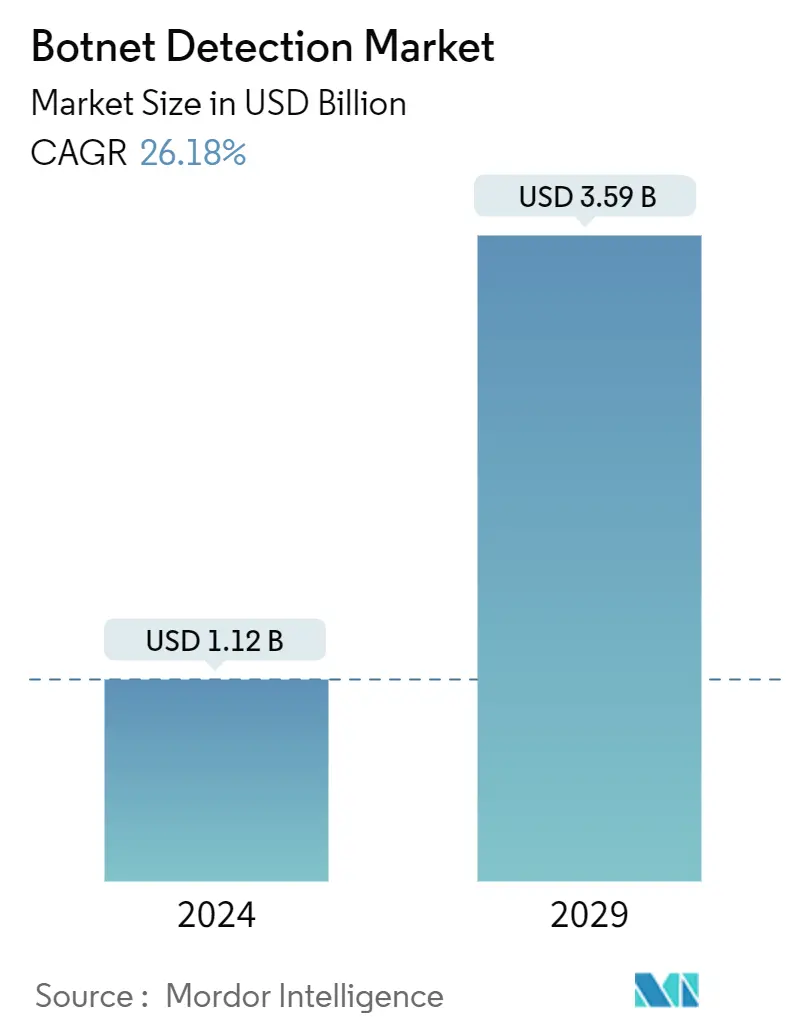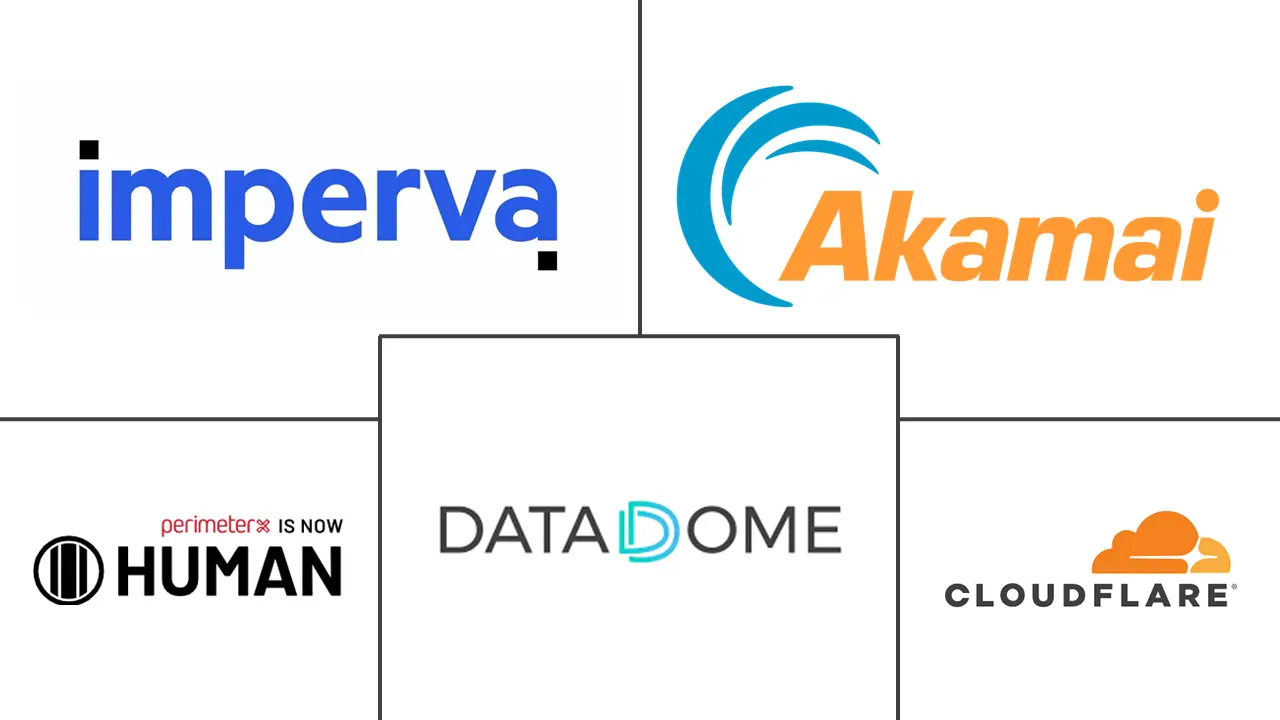Market Size of Botnet Detection Industry

| Study Period | 2019 - 2029 |
| Market Size (2024) | USD 1.12 Billion |
| Market Size (2029) | USD 3.59 Billion |
| CAGR (2024 - 2029) | 26.18 % |
| Fastest Growing Market | Asia Pacific |
| Largest Market | North America |
Major Players
*Disclaimer: Major Players sorted in no particular order |
Botnet Detection Market Analysis
The Botnet Detection Market size is estimated at USD 1.12 billion in 2024, and is expected to reach USD 3.59 billion by 2029, growing at a CAGR of 26.18% during the forecast period (2024-2029).
Botnet detection has accumulated widespread attention among cybersecurity professionals and technology companies worldwide. As technology progresses across the globe, the risk connected with the misuse of advanced technology has also grown over the past years. Botnet attack is one such violation of the user's privacy where a user's computer is being controlled and managed by a third party. The botnet has been developing as one of the principal threats owing to the growing cybercriminals' capacity to infiltrate any of the devices which are attached to the internet across the globe.
- In recent years, there has been a proliferation in the Internet of Things (IoT) technology, which added additional endpoints for attackers. The emergence of new distributed denial of service (DDoS) bots at an increasing regularity attributes to the changes in the landscape. After the reporting of the Mirai botnet in 2016 and the subsequent leak of the malware's source code, the number of variants of this family of botnets has been growing steadily, its success being augmented by an environment of poorly-managed IoT devices.
- Due to the growth of mobile devices and cloud computing that act as attack surfaces, it has become easier for malicious bots to disguise themselves. The hackers traditionally used malicious bots for money-making activities. Now, they are increasingly used for industrial espionage and even influencing elections. Companies have to index attacks intensively and study them before countering them with their strategies. In December 2021, Google disrupted the 'key command and control infrastructure' of Glupteba, a botnet that compromised nearly one million Windows devices worldwide, and filed a lawsuit against its operators.
- The convergence of physical security with the IP network expands the attack surface for cybercriminals. Criminals have expanded from targeting specific user accounts or regions to conquering entire internet entities. In September 2021, the Russian search engine Yandex was attacked at a record level by a distributed denial of service attack by the Meris botnet. The attack destroyed the company's web infrastructure with millions of HTTP requests before hitting a peak of 21.8 million requests per second (RPS) and destabilizing its existing infrastructure. The Russian DDoS mitigation service Qrator Labs identified the attack and noted that the DDoS attacks leveraged HTTP pipelining originating from over 250,000 infected network devices from Mikrotik.
- However, the lack of skilled cybersecurity professionals to disrupt such attacks continues to be a vulnerability that companies face. The companies are recruiting new cybersecurity professionals to train them with the evolution of botnets and use detection software to prevent potential attacks. Mergers among the big players in the market are another solution the companies have come up with to strengthen their services and product portfolio.
- COVID-19 spam was a prevalent issue during the lockdown period and can be primarily divided into two types: with and without attachments. Vendors have had to rapidly roll out new offerings that match the pace of attackers worldwide. In July 2021, as the second wave of the virus surged, Neustar Inc. introduced UltraBot Protect to deliver enhanced capabilities to users to examine traffic patterns to determine risk, easily set rules, and block nefarious web application traffic through an intuitive and comprehensive user interface or the company's extensible API, which deliver actionable data to manage incoming traffic or risks better.
Botnet Detection Industry Segmentation
A botnet is a collection of connected devices over the public internet, typically consisting of compromised workstations, servers, and devices in the Internet of Things (IoT) affected by malicious or ill-disposed software and malware. Botnets are regulated by a particular attacker or a group who uses them primarily for criminal or malicious purposes. Companies deploy preventive software to detect such attacks and guard the company's assets.
The Botnet Detection Market is segmented by Component (Solution and Service), Deployment Type (On-premise and Cloud), Organization Size (SMEs and Large Enterprises), End-user Vertical (Retail, BFSI, Travel & Hospitality, IT & Telecom, Media & Entertainment), and Geography.
| By Component | |
| Solution | |
| Service |
| By Deployment Type | |
| On-premise | |
| Cloud |
| By Organization Size | |
| SMEs | |
| Large Enterprise |
| By End-user Vertical | |
| Retail | |
| BFSI | |
| Travel & Hospitality | |
| IT &Telecom | |
| Media & Entertainment | |
| Other End-user Verticals (Education, Healthcare, and Real Estate) |
| Geography | ||||||
| ||||||
| ||||||
| ||||||
|
Botnet Detection Market Size Summary
The botnet detection market is experiencing significant growth, driven by the increasing prevalence of cyber threats and the evolving landscape of technology. As cybercriminals become more adept at exploiting vulnerabilities in internet-connected devices, the demand for robust botnet detection solutions is rising. The proliferation of IoT devices and the rise of mobile and cloud computing have expanded the attack surface, making it easier for malicious bots to operate. This has led to a surge in botnet attacks, including distributed denial of service (DDoS) attacks, which have targeted major companies and infrastructure globally. The media and entertainment sector, in particular, is witnessing rapid growth in botnet detection adoption due to the rising incidence of ad fraud and other malicious activities that threaten brand integrity and revenue.
North America is poised to be a leading region in the botnet detection market, fueled by substantial investments in cybersecurity solutions and a strong focus on research and development. The region's growth is further supported by stringent government measures against botnet threats and increasing awareness of data privacy issues. The market is moderately competitive, with major players dominating and new entrants seeking to capture market share through strategic partnerships and acquisitions. Companies are actively enhancing their product offerings and capabilities to address the evolving threat landscape. The ongoing digital transformation and the need for robust security measures across various sectors are expected to drive the market's expansion in the coming years.
Botnet Detection Market Size - Table of Contents
-
1. MARKET DYNAMICS
-
1.1 Market Overview
-
1.2 Introduction to Market Drivers and Restraints
-
1.3 Market Drivers
-
1.3.1 Increasing Number of Connected Devices
-
1.3.2 Increasing Need For Security against Botnet in Organizations
-
1.3.3 Increasing Usage of APIs By Online Businesses
-
-
1.4 Market Restraints
-
1.4.1 Lack of Education among Users and Low Usage of Tools
-
1.4.2 Use of Conventional BOT Protection Methods, Such as Captcha Or Create Account
-
-
1.5 Industry Attractiveness - Porter's Five Force Analysis
-
1.5.1 Threat of New Entrants
-
1.5.2 Bargaining Power of Buyers/Consumers
-
1.5.3 Bargaining Power of Suppliers
-
1.5.4 Threat of Substitute Products
-
1.5.5 Intensity of Competitive Rivalry
-
-
1.6 Technology Overview
-
-
2. MARKET SEGMENTATION
-
2.1 By Component
-
2.1.1 Solution
-
2.1.2 Service
-
-
2.2 By Deployment Type
-
2.2.1 On-premise
-
2.2.2 Cloud
-
-
2.3 By Organization Size
-
2.3.1 SMEs
-
2.3.2 Large Enterprise
-
-
2.4 By End-user Vertical
-
2.4.1 Retail
-
2.4.2 BFSI
-
2.4.3 Travel & Hospitality
-
2.4.4 IT &Telecom
-
2.4.5 Media & Entertainment
-
2.4.6 Other End-user Verticals (Education, Healthcare, and Real Estate)
-
-
2.5 Geography
-
2.5.1 North America
-
2.5.1.1 United States
-
2.5.1.2 Canada
-
-
2.5.2 Europe
-
2.5.2.1 United Kingdom
-
2.5.2.2 Germany
-
2.5.2.3 France
-
2.5.2.4 Rest of Europe
-
-
2.5.3 Asia Pacific
-
2.5.3.1 China
-
2.5.3.2 India
-
2.5.3.3 Japan
-
2.5.3.4 Rest of Asia-Pacific
-
-
2.5.4 Rest of the World
-
2.5.4.1 Latin America
-
2.5.4.2 Middle East & Africa
-
-
-
Botnet Detection Market Size FAQs
How big is the Botnet Detection Market?
The Botnet Detection Market size is expected to reach USD 1.12 billion in 2024 and grow at a CAGR of 26.18% to reach USD 3.59 billion by 2029.
What is the current Botnet Detection Market size?
In 2024, the Botnet Detection Market size is expected to reach USD 1.12 billion.

